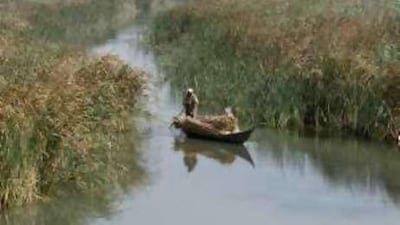UNITED NATIONS // Despite links to the Bible, the Epic of Gilgamesh and Sir Wilfred Thesiger, the British explorer, years of damage and neglect reduced the once-verdant marshlands of southern Iraq to a crusty wasteland. A combination of Saddam Hussein's punitive policies and dams upstream of the Tigris and Euphrates delta pushed the swampy home of the famed Marsh Arabs into rapid decline.
But this month, UN environment chiefs said conservation work was proving successful and announced plans to gain the rejuvenated wetlands an inscription on the famed World Heritage List of the UN Educational, Scientific and Cultural Organization (Unesco). Derek Kennet, an archaeologist from Durham University, said academics were attracted to the swamplands' unusual ecosystems and societies as well as their associations with folklore, myth and literature.
"It's an important area, but also a problematic area because of the flooding," Mr Kennet said. "It offers such a unique environment in the Near East that I would think that Unesco is likely to approve it. "Because of the way the Bible was written, the area has been linked with the story of Gilgamesh, the flood myth and the story of the Garden of Eden. But, of course, that is just speculation." Southern Mesopotamia's interconnected marshlands and lakes are home to a predominantly Shiite population, the Ma'dan, whose way of life was preserved through relative isolation for 5,000 years.
The explorer Thesiger chronicled the lives of swamp-dwelling tribes in his 1964 classic The Marsh Arabs, having spent months living with remote communities during the 1950s. At that time, an estimated 400,000 people eked out subsistence livings among muddy waterways and islets, building delicately arched dwellings from marsh reeds and dining on fish and water buffalo. Archaeologists and literature buffs have theorised about references to the Marsh Arabs, heirs to the heritage of two great Fertile Crescent civilisations - the Babylonians and Sumerians - in ancient texts.
Some claim that the river basin was the Garden of Eden described in the Book of Genesis. Others argue that the area's rising and falling water levels were translated into the deluge myth that appears in the Noah's Ark story and the Epic of Gilgamesh. Until the 1970s, the marshlands at the foot of the Tigris and Euphrates covered an area of 20,000 sq km during heavy rains, but dam building in Syria and Turkey began to take their toll on river flows.
The process was accelerated under Saddam's rule following the 1980-88 war with Iran, when his government built dams and canals to starve the wetlands of water during a spate of punitive policies against Shiites. By 2002, the permanent wetlands had dwindled to an area of only 760km, and as many as 300,000 Marsh Arabs were forced to leave their homes and head for camps in Iraq and abroad. "Because of what Saddam Hussein did, the marshlands were in danger of completely disappearing, as was the centuries-old culture of the Marsh Arabs," said Narmin Othman, Iraq's environment minister. "It had become an ecological but also a human tragedy."
After the toppling of Saddam in April 2003, surviving residents began breaking the embankments and opening the floodgates to allow water back into the marshlands. The following year, UN Environment Programme (Unep) workers began planting reed banks, installing solar panels and providing drinking water systems for 22,000 people as part of a wetland restoration plan. The most recent satellite images show that the four-year project, costing US$14 million (Dh51.4m), has restored about 58 per cent of the marshlands.
Thanks to a recent funding pledge from Italy, Unep officials announced this month that Iraqi conservationists will turn the wetlands into a national park and apply for a place on the list of World Heritage Sites. The application will boast of the marshlands' cultural and natural importance, being home to a unique population as well as a spawning ground for Gulf fisheries and a variety of birds, including the ibis. Officials plan to apply in 2010 and hope the bid will be accepted the following year.
Iraq already has three sites on the heritage list following the inscription of Samarra - an important Islamic city from the Abbasid Empire that boasts distinctive spiralling minarets - in June last year. The country's other sites are the cities of Ashur and Hatra. jreinl@thenational.ae


